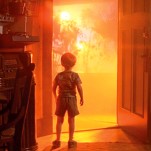Sufjan Stevens and the Enduring, Unearthly Magic of Michigan
20 years on, we look back on the singer/songwriter's complex tribute to the state he grew up in

When you think about Sufjan Stevens, you think about 2005’s expansive, tomelike Illinois. Maybe then you remember the 50 States Project. And then, perhaps, after all that’s out of the way, you remember 2003’s Michigan. Stevens’s breakout third album suffers from constant comparison to its broader-scale, more polished sibling. On its face, Illinois may be a greater feat, if just for the man-hours it demanded from Stevens in its creation—the Midwestern instrumentalist did months of eyeball-straining research on the state’s history, from Saul Bellow to Casimir Pulaski to John Wayne Gacy, Jr. The record is tall and proud, a far-spanning, painstakingly hand-sewn tapestry of the Prairie State.
But we’re not talking about Illinois today, really; it’s been raved about enough. Turn your gaze northeast instead, over to an awkwardly shaped duo of peninsulas cradled tenderly by four of the Great Lakes. Look to the Canadian border and watch deer bound through enormous forests of aspen and fir. Trace your fingers along the peeling paint and green-gray metals of the Rust Belt’s belly, imagining what it must have been like when the factories shut down and the wheels stopped turning. You’re in Michigan now, where Stevens spent the first 22 years of his life, and everything he’ll tell you about the state is interfused with the years he spent there, becoming himself.
You can’t expect Michigan to be as historical as Illinois—and if mapping the state’s geography is your main concern, may I point you away from folk revivalism and toward Fodor’s Travel Guide. There’s no way to call for Stevens to pan out to a birds-eye view of the place he knows all the darkest nooks and crannies of, where he’s gone through those thousand tiny heartbreaks that make up our youth. Michigan isn’t really a concept album, at least not in the way Illinois is. It’s a personal, ancestral history; a self-portrait wrought in the negative. Through images of fractured faith, of railways and rust, shopping malls and snowstorms, Stevens cracks himself open for us. It’s microscopic and injured and real in a way that Illinois is not, and only the two albums together can create a complete picture of the American tragedy Sufjan exorcises from his chords.
Michigan was produced and recorded almost entirely by Stevens himself, with album art by Martha Stewart Living crafts editor Laura Normandin. It traces its way through the state in 66 minutes, with songs ranging from barely a minute to almost 10. Most of its song titles reference the cities and towns which dot the large state’s frozen sprawl, or the working-class people who fill them. It tells tales of Detroit, where Stevens was born; Alanson, where he grew restless and left home; and Holland, the small town which housed Hope College, his private Christian alma mater. What Michigan lacks in the mysticism that permeates Illinois, it makes up for in the throbbing pathos of working-class, Midwestern hurt.
Much of the album’s anguish is expressed in only 86 distinct words, a testament to Stevens’s incredible evocative abilities using nonverbal vocalization and the kinds of shimmering, swelling instruments your middle-school orchestra teacher could only dream of. Glockenspiels, banjos, recorders, vibraphones and horns emphasize the idiosyncratic landscape of Stevens’s musical mind—creating a sound unmistakably his own. These irreplaceable melodies are the snow falling on the ground, the fresh skates on frozen lakewater, the cars towed and coats fluttering of Stevens’s formative years. Close your eyes during “Tahquamenon Falls,” an instrumental piece cushioned safely in the middle of the record, and listen to the water cascading over the rocks. Or “Alanson, Crooked River,” whose notes read like droplets flitting forth atop a rushing tide. It’s balletic.
-

-

-

-

-

-

-

-

-

-

-

-

-

-

-

-

-

-

-

-

-

-

-

-

-

-

-

-

-

-

-

-

-

-

-

-

-

-

-

-








































